目录
- 1、起步
- 项目结构
- App.vue
- webpack.config.js
- 打包构建
- vue-loader 源码
- template-loader
- 2、模板编译流程
- parseHTML 阶段
- genElement 阶段
- compilerToFunction 阶段
- parseHTML 阶段
- genElement 阶段
- 3、总结
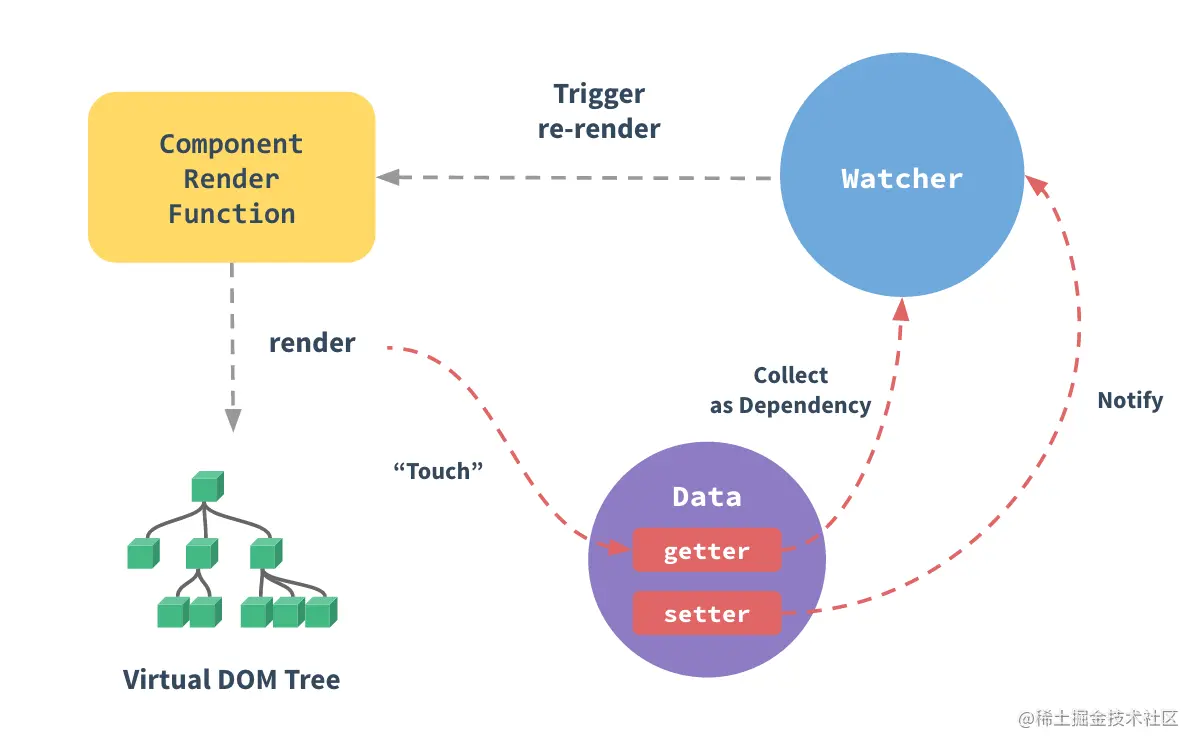
为了更好理解 vue 的模板编译这里我整理了一份模板编译的整体流程,如下所示,下面将用源码解读的方式来找到模板编译中的几个核心步骤,进行详细说明:
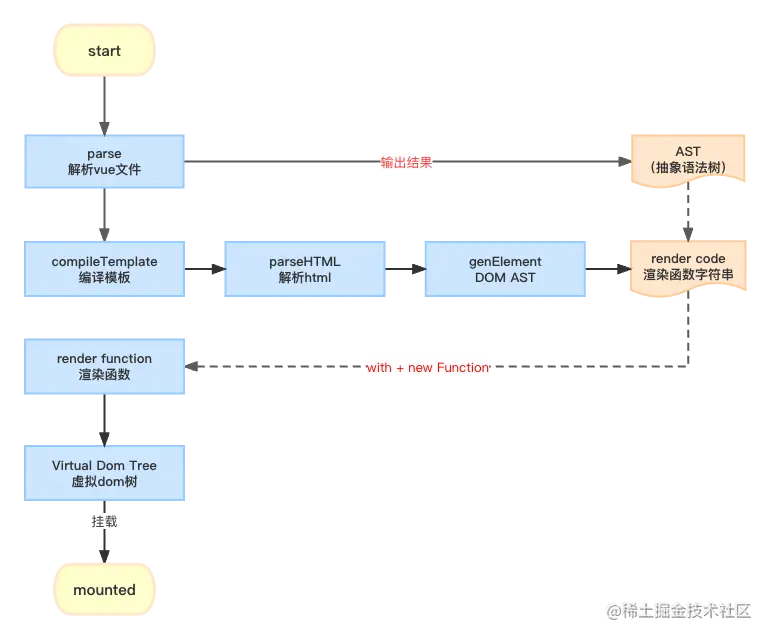
1、起步
这里我使用 webpack 来打包 vue 文件,来分析 vue 在模板编译中的具体流程,如下所示,下面是搭建的项目结构和文件内容:
项目结构
├─package-lock.json ├─package.json ├─src | ├─App.vue | └index.js ├─dist | └main.js ├─config | └webpack.config.js
App.vue
<template>
<div id="box">
{{ count }}
</div>
</template>
<script>
export default {
props: {},
data() {
return {
count: 0
}
}
}
</script>
<style scoped>
#box {
background: red;
}
</style>
webpack.config.js
const { VueLoaderPlugin } = require('vue-loader')
module.exports = {
mode: 'development',
module: {
rules: [
{
test: /.vue$/,
loader: 'vue-loader'
},
// 它会应用到普通的 `.js` 文件
// 以及 `.vue` 文件中的 `<script>` 块
{
test: /.js$/,
loader: 'babel-loader'
},
// 它会应用到普通的 `.css` 文件
// 以及 `.vue` 文件中的 `<style>` 块
{
test: /.css$/,
use: [
'vue-style-loader',
'css-loader'
]
}
]
},
plugins: [
new VueLoaderPlugin()
]
}
如上 webpack.config.js 所示,webpack 可以通过 vue-loader 识别 vue 文件,vue-loader 是 webpack 用来解析 .vue 文件的 loader,主要作用是将单文件组件(SFC),解析成为 webpack 可识别的 JavaScript 模块。
打包构建
搭建好整个目录项目后,执行 npm run build ,会将 vue 文件解析打包成对应的 bundle,并输出至 dist 目录下,下面是打包后的产出,对应 App.vue 的产物:
/***/ "./src/App.vue"
__webpack_require__.r(__webpack_exports__);
/* harmony export */ __webpack_require__.d(__webpack_exports__, {
/* harmony export */ "default": () => (__WEBPACK_DEFAULT_EXPORT__) \n/* harmony export */
});
var _App_vue_vue_type_template_id_7ba5bd90_scoped_true___WEBPACK_IMPORTED_MODULE_0__ = __webpack_require__("./src/App.vue?vue&type=template&id=7ba5bd90&scoped=true&");
var _App_vue_vue_type_script_lang_js___WEBPACK_IMPORTED_MODULE_1__ = __webpack_require__( "./src/App.vue?vue&type=script&lang=js&");
var _node_modules_vue_loader_lib_runtime_componentNormalizer_js__WEBPACK_IMPORTED_MODULE_2__ = __webpack_require__("./node_modules/vue-loader/lib/runtime/componentNormalizer.js");
var component = (0, _node_modules_vue_loader_lib_runtime_componentNormalizer_js__WEBPACK_IMPORTED_MODULE_2__["default"])(
_App_vue_vue_type_script_lang_js___WEBPACK_IMPORTED_MODULE_1__["default"],
_App_vue_vue_type_template_id_7ba5bd90_scoped_true___WEBPACK_IMPORTED_MODULE_0__.render, _App_vue_vue_type_template_id_7ba5bd90_scoped_true___WEBPACK_IMPORTED_MODULE_0__.staticRenderFns, false, null, "7ba5bd90", null,/* hot reload */
)
从上方的产物可以看出,App.vue 文件被编译分为三块,_App_vue_vue_type_template_id_7ba5bd90_scoped_true___WEBPACK_IMPORTED_MODULE_0__ 、 _App_vue_vue_type_script_lang_js___WEBPACK_IMPORTED_MODULE_1__,_node_modules_vue_loader_lib_runtime_componentNormalizer_js__WEBPACK_IMPORTED_MODULE_2__,这三个模块恰好对应vue模板中的 template、script、style这三个标签的模板内容,所以得出结论:vue-loader 会将 vue 模板中的template、script、style 标签内容分解为三个模块。 为此,我找到 vue-loader 的源码,下面分析其源码逻辑:
vue-loader 源码
源码里很清楚的可以看到 vue-loader 使用了 vue/compiler-sfc 中的 parse 方法对 vue 的源文件进行的解析,将模板语法解析为一段可描述的对象
module.exports = function (source) {
// 这里就是.vue文件的AST
const loaderContext = this
...
// 解析.vue原文件,source对应的就是.vue模板
const descriptor = compiler.parse({
source,
compiler: options.compiler || templateCompiler,
filename,
sourceRoot,
needMap: sourceMap
})
...
// 使用webpack query source
let templateImport = `var render, staticRenderFns`
let templateRequest
if (descriptor.template) {
const src = descriptor.template.src || resourcePath
const idQuery = `&id=${id}`
const scopedQuery = hasScoped ? `&scoped=true` : ``
const attrsQuery = attrsToQuery(descriptor.template.attrs)
// const tsQuery =
// options.enableTsInTemplate !== false && isTS ? `&ts=true` : ``
const query = `?vue&type=template${idQuery}${scopedQuery}${attrsQuery}${inheritQuery}`
const request = (templateRequest = stringifyRequest(src + query))
templateImport = `import { render, staticRenderFns } from ${request}`
}
...
code += `\nexport default component.exports`
return code
}
对 descriptor 进行打印,输出结果如下,vue-loader 对源文件编译后,vue 模板会被转化成抽象语法树(AST),此处便是模板编译的入口,使用编译后的 AST 将 vue 模板拆分为 template 、script 和 style 三部分,方便后面 webpack 通过 resourceQuery 匹配分发到各个loader 进行二次解析编译,template 部分会被 template-loader 进行二次编译解析,最终生成render 函数。
{
source: '<template>\n' +
' <div id="box">\n' +
' {{ count }}\n' +
' </div>\n' +
'</template>\n' +
'\n' +
'<script>\n' +
'export default {\n' +
' props: {},\n' +
' data() {\n' +
' return {\n' +
' count: 0\n' +
' }\n' +
' }\n' +
'}\n' +
'</script>\n' +
'\n' +
'<style>\n' +
'#box {\n' +
' background: red;\n' +
'}\n' +
'</style>\n',
filename: 'App.vue',
template: {
type: 'template',
content: '\n<div id="box">\n {{ count }}\n</div>\n',
start: 10,
end: 53,
attrs: {}
},
script: {
type: 'script',
content: '\n' +
'export default {\n' +
' props: {},\n' +
' data() {\n' +
' return {\n' +
' count: 0\n' +
' }\n' +
' }\n' +
'}\n',
start: 74,
end: 156,
attrs: {}
},
....
}
template-loader
template-loader 的作用是将 import { render, staticRenderFns } from "./App.vue?vue&type=template&id=7ba5bd90&" 模块编译成 render 函数并导出,以下是编译产物:
// 编译前
<div id="box">
{{ count }}
</div>
// 编译后
var render = function render() {
var _vm = this,
_c = _vm._self._c
return _c("div", { attrs: { id: "box" } }, [
_vm._v("\n " + _vm._s(_vm.count) + "\n"),
])
}
var staticRenderFns = []
render._withStripped = true
export { render, staticRenderFns }
template-loader 核心原理是通过 vue/compiler-sfc 将模板转换成为 render 函数,并返回 template 编译产物
module.exports = function (source) {
const loaderContext = this
...
// 接收模板编译核心库
const { compiler, templateCompiler } = resolveCompiler(ctx, loaderContext)
...
// 开启编译
const compiled = compiler.compileTemplate(finalOptions)
...
// 编译后产出,code就是render函数
const { code } = compiled
// 导出template模块
return code + `\nexport { render, staticRenderFns }`
}
2、模板编译流程
vue/compiler-sfc 是模板编译的核心库,在 vue2.7 版本中使用,而 vue2.7 以下的版本都是使用vue-template-compiler,本质两个包的功能是一样的,都可以将模板语法编译为 JavaScript,接下来我们来解析一下在模板编译过程中使用的方法:
parseHTML 阶段
可以将 vue 文件中的模板语法转义为 AST,为后续创建 dom 结构做预处理
export function parseHTML(html, options: HTMLParserOptions) {
// 存储解析后的标签
const stack: any[] = []
const expectHTML = options.expectHTML
const isUnaryTag = options.isUnaryTag || no
const canBeLeftOpenTag = options.canBeLeftOpenTag || no
let index = 0
let last, lastTag
// 循环 html 字符串结构
while (html) {
// 记录当前最新html
last = html
if (!lastTag || !isPlainTextElement(lastTag)) {
// 获取以 < 为开始的位置
let textEnd = html.indexOf('<')
if (textEnd === 0) {
// 解析注释
if (comment.test(html)) {
const commentEnd = html.indexOf('-->')
if (commentEnd >= 0) {
if (options.shouldKeepComment && options.comment) {
options.comment(
html.substring(4, commentEnd),
index,
index + commentEnd + 3
)
}
advance(commentEnd + 3)
continue
}
}
// 解析条件注释
if (conditionalComment.test(html)) {
const conditionalEnd = html.indexOf(']>')
if (conditionalEnd >= 0) {
advance(conditionalEnd + 2)
continue
}
}
// 解析 Doctype
const doctypeMatch = html.match(doctype)
if (doctypeMatch) {
advance(doctypeMatch[0].length)
continue
}
// 解析截取结束标签
const endTagMatch = html.match(endTag)
if (endTagMatch) {
const curIndex = index
advance(endTagMatch[0].length)
parseEndTag(endTagMatch[1], curIndex, index)
continue
}
// 解析截取开始标签
const startTagMatch = parseStartTag()
if (startTagMatch) {
handleStartTag(startTagMatch)
if (shouldIgnoreFirstNewline(startTagMatch.tagName, html)) {
advance(1)
}
continue
}
}
let text, rest, next
if (textEnd >= 0) {
rest = html.slice(textEnd)
while (
!endTag.test(rest) &&
!startTagOpen.test(rest) &&
!comment.test(rest) &&
!conditionalComment.test(rest)
) {
// < in plain text, be forgiving and treat it as text
next = rest.indexOf('<', 1)
if (next < 0) break
textEnd += next
rest = html.slice(textEnd)
}
text = html.substring(0, textEnd)
}
// 纯文本节点
if (textEnd < 0) {
text = html
}
// 截取文本节点
if (text) {
advance(text.length)
}
if (options.chars && text) {
options.chars(text, index - text.length, index)
}
} else {
let endTagLength = 0
const stackedTag = lastTag.toLowerCase()
const reStackedTag =
reCache[stackedTag] ||
(reCache[stackedTag] = new RegExp(
'([\s\S]*?)(</' + stackedTag + '[^>]*>)',
'i'
))
const rest = html.replace(reStackedTag, function (all, text, endTag) {
endTagLength = endTag.length
if (!isPlainTextElement(stackedTag) && stackedTag !== 'noscript') {
text = text
.replace(/<!--([\s\S]*?)-->/g, '$1') // #7298
.replace(/<![CDATA[([\s\S]*?)]]>/g, '$1')
}
if (shouldIgnoreFirstNewline(stackedTag, text)) {
text = text.slice(1)
}
if (options.chars) {
options.chars(text)
}
return ''
})
index += html.length - rest.length
html = rest
parseEndTag(stackedTag, index - endTagLength, index)
}
if (html === last) {
options.chars && options.chars(html)
break
}
}
// 清空闭合标签
parseEndTag()
// 截取标签,前后推进位置
function advance(n) {
index += n
html = html.substring(n)
}
// 解析开始标签
function parseStartTag() {
const start = html.match(startTagOpen)
if (start) {
const match: any = {
tagName: start[1],
attrs: [],
start: index
}
advance(start[0].length)
let end, attr
while (
!(end = html.match(startTagClose)) &&
(attr = html.match(dynamicArgAttribute) || html.match(attribute))
) {
attr.start = index
advance(attr[0].length)
attr.end = index
match.attrs.push(attr)
}
if (end) {
match.unarySlash = end[1]
advance(end[0].length)
match.end = index
return match
}
}
}
// 匹配处理开始标签
function handleStartTag(match) {
const tagName = match.tagName
const unarySlash = match.unarySlash
if (expectHTML) {
if (lastTag === 'p' && isNonPhrasingTag(tagName)) {
parseEndTag(lastTag)
}
if (canBeLeftOpenTag(tagName) && lastTag === tagName) {
parseEndTag(tagName)
}
}
const unary = isUnaryTag(tagName) || !!unarySlash
const l = match.attrs.length
const attrs: ASTAttr[] = new Array(l)
for (let i = 0; i < l; i++) {
const args = match.attrs[i]
const value = args[3] || args[4] || args[5] || ''
const shouldDecodeNewlines =
tagName === 'a' && args[1] === 'href'
? options.shouldDecodeNewlinesForHref
: options.shouldDecodeNewlines
attrs[i] = {
name: args[1],
value: decodeAttr(value, shouldDecodeNewlines)
}
if (__DEV__ && options.outputSourceRange) {
attrs[i].start = args.start + args[0].match(/^\s*/).length
attrs[i].end = args.end
}
}
if (!unary) {
stack.push({
tag: tagName,
lowerCasedTag: tagName.toLowerCase(),
attrs: attrs,
start: match.start,
end: match.end
})
lastTag = tagName
}
if (options.start) {
options.start(tagName, attrs, unary, match.start, match.end)
}
}
// 解析结束标签
function parseEndTag(tagName?: any, start?: any, end?: any) {
let pos, lowerCasedTagName
if (start == null) start = index
if (end == null) end = index
// Find the closest opened tag of the same type
if (tagName) {
lowerCasedTagName = tagName.toLowerCase()
for (pos = stack.length - 1; pos >= 0; pos--) {
if (stack[pos].lowerCasedTag === lowerCasedTagName) {
break
}
}
} else {
// If no tag name is provided, clean shop
pos = 0
}
if (pos >= 0) {
// Close all the open elements, up the stack
for (let i = stack.length - 1; i >= pos; i--) {
if (__DEV__ && (i > pos || !tagName) && options.warn) {
options.warn(`tag <${stack[i].tag}> has no matching end tag.`, {
start: stack[i].start,
end: stack[i].end
})
}
if (options.end) {
options.end(stack[i].tag, start, end)
}
}
// Remove the open elements from the stack
stack.length = pos
lastTag = pos && stack[pos - 1].tag
} else if (lowerCasedTagName === 'br') {
if (options.start) {
options.start(tagName, [], true, start, end)
}
} else if (lowerCasedTagName === 'p') {
if (options.start) {
options.start(tagName, [], false, start, end)
}
if (options.end) {
options.end(tagName, start, end)
}
}
}
}
genElement 阶段
genElement 会将 AST 预发转义为字符串代码,后续可将其包装成 render 函数的返回值
// 将AST预发转义成render函数字符串
export function genElement(el: ASTElement, state: CodegenState): string {
if (el.parent) {
el.pre = el.pre || el.parent.pre
}
if (el.staticRoot && !el.staticProcessed) {
// 输出静态树
return genStatic(el, state)
} else if (el.once && !el.onceProcessed) {
// 处理v-once指令
return genOnce(el, state)
} else if (el.for && !el.forProcessed) {
// 处理循环结构
return genFor(el, state)
} else if (el.if && !el.ifProcessed) {
// 处理条件语法
return genIf(el, state)
} else if (el.tag === 'template' && !el.slotTarget && !state.pre) {
// 处理子标签
return genChildren(el, state) || 'void 0'
} else if (el.tag === 'slot') {
// 处理插槽
return genSlot(el, state)
} else {
// 处理组件和dom元素
...
return code
}
}
通过genElement函数包装处理后,将vue 模板的 template 标签部分转换为 render 函数,如下所示:
const compiled = compiler.compileTemplate({
source: '\n' +
'<div id="box">\n' +
' {{ count }}\n' +
' <button @add="handleAdd">+</button>\n' +
'</div>\n'
});
const { code } = compiled;
// 编译后
var render = function render() {
var _vm = this,
_c = _vm._self._c
return _c("div", { attrs: { id: "box" } }, [
_vm._v("\n " + _vm._s(_vm.count) + "\n "),
_c("button", { on: { add: _vm.handleAdd } }, [_vm._v("+")]),
])
}
var staticRenderFns = []
render._withStripped = true
compilerToFunction 阶段
将 genElement 阶段编译的字符串产物,通过 new Function将 code 转为函数
export function createCompileToFunctionFn(compile: Function): Function {
const cache = Object.create(null)
return function compileToFunctions(
template: string,
options?: CompilerOptions,
vm?: Component
): CompiledFunctionResult {
...
// 编译
const compiled = compile(template, options)
// 将genElement阶段的产物转化为function
function createFunction(code, errors) {
try {
return new Function(code)
} catch (err: any) {
errors.push({ err, code })
return noop
}
}
const res: any = {}
const fnGenErrors: any[] = []
// 将code转化为function
res.render = createFunction(compiled.render, fnGenErrors)
res.staticRenderFns = compiled.staticRenderFns.map(code => {
return createFunction(code, fnGenErrors)
})
...
}
}
为了方便理解,使用断点调试,来看一下 compileTemplate 都经历了哪些操作:

首先会判断是否需要预处理,如果需要预处理,则会对 template 模板进行预处理并返回处理结果,此处跳过预处理,直接进入 actuallCompile 函数
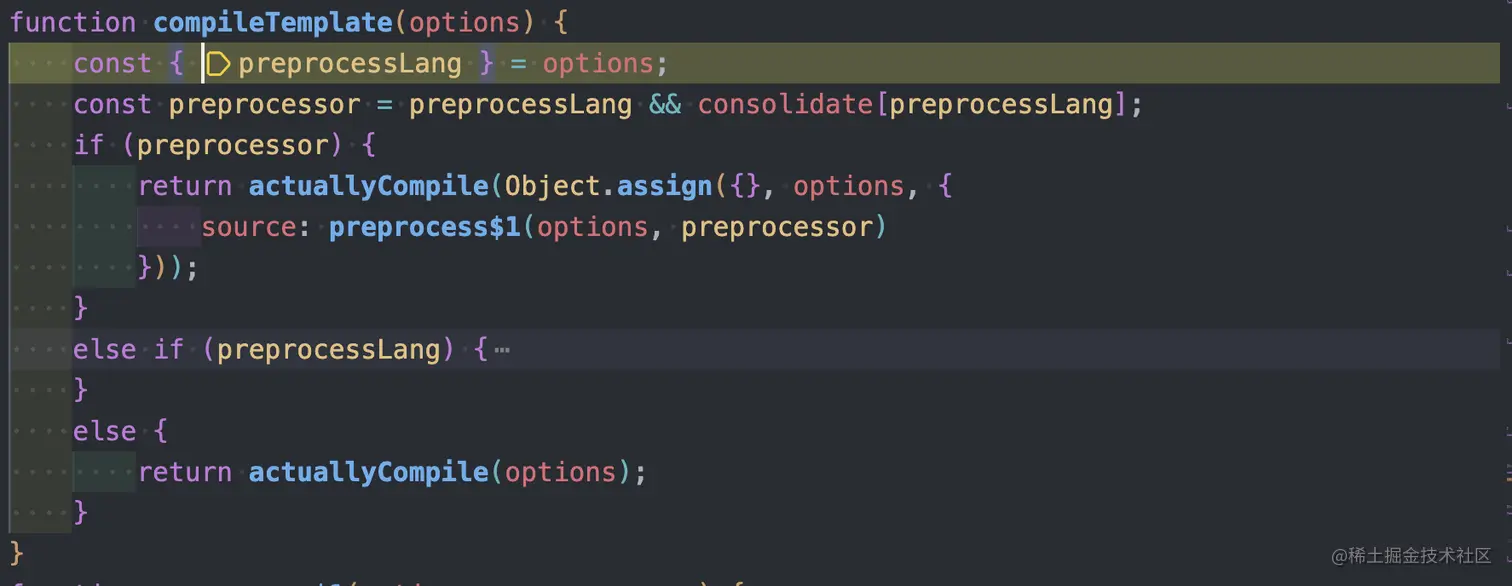
这里可以看到本身内部还有一层编译函数对 template 进行编译,这才是最核心的编译方法,而这个 compile 方法来源于 createCompilerCreator
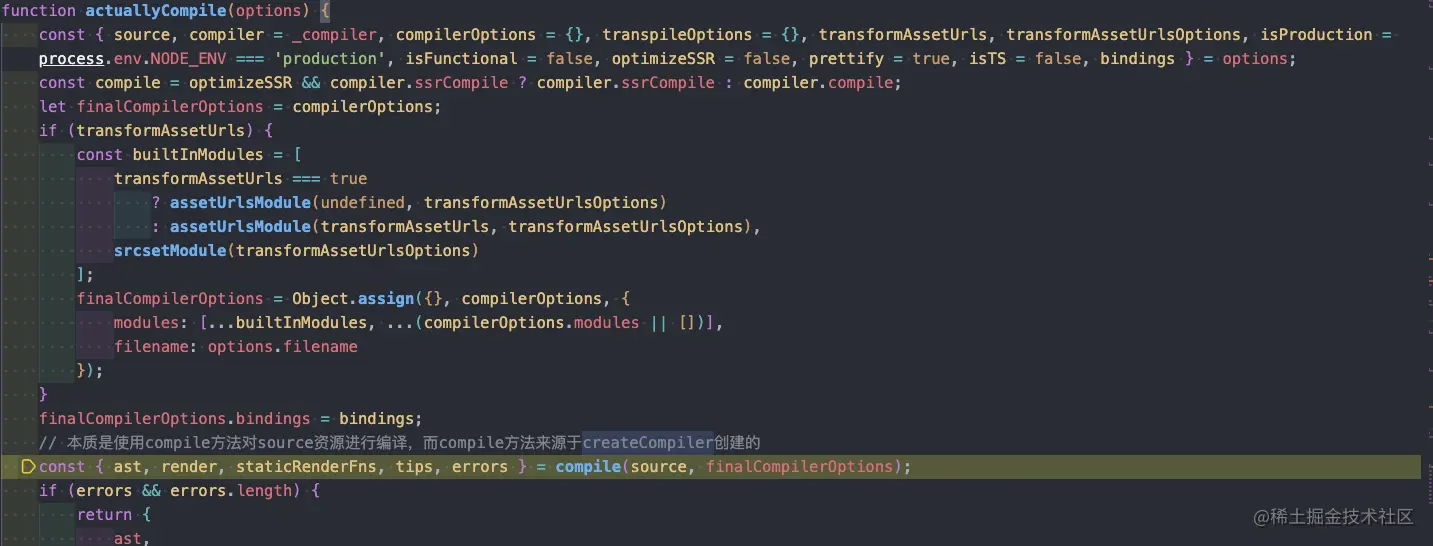
createCompilerCreator 返回了两层函数,最终返回值则是 compile 和 compileToFunction,这两个是将 template 转为 render 函数的关键,可以看到 template 会被解析成 AST 树,最后通过 generate 方法转义成函数 code,接下来我们看一下parse函数中是如何将 template 转为 AST 的。

继续向下 debug 后,会走到 parseHTML 函数,这个函数是模板编译中用来解析 HTML 结构的核心方法,通过回调 + 递归最终遍历整个 HTML 结构并将其转化为 AST 树。
parseHTML 阶段
使用 parseHTML 解析成的 AST 创建 render 函数和 Vdom
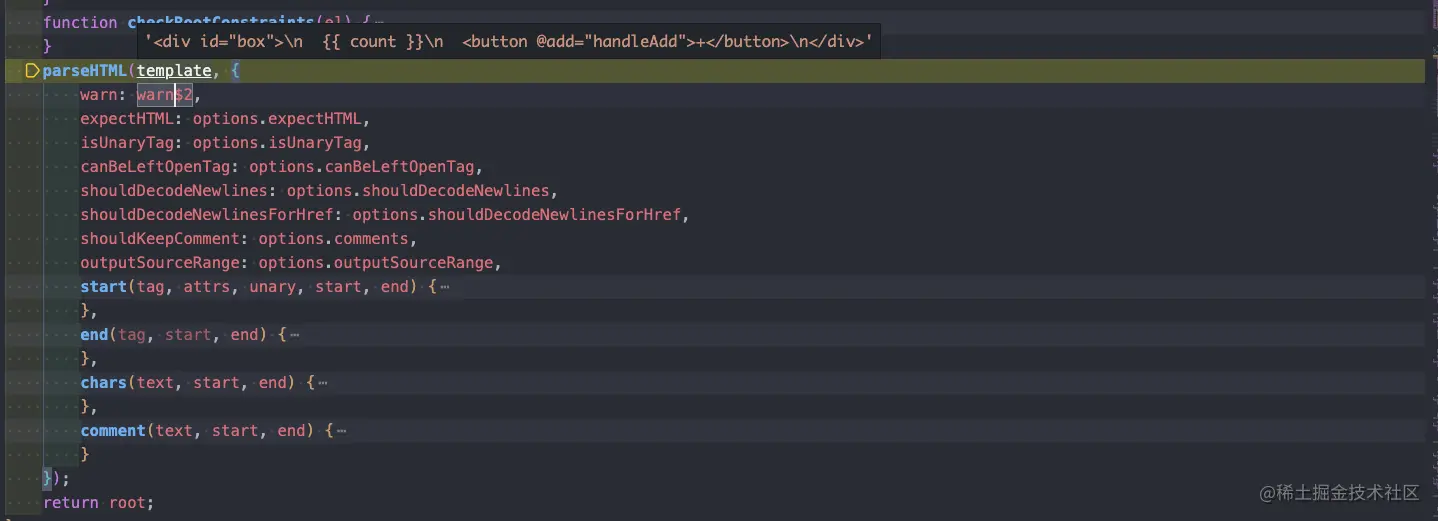
genElement 阶段
将 AST 结构解析成为虚拟 dom 树

最终编译输出为 render 函数,得到最终打包构建的产物。

3、总结
到此我们应该了解了 vue 是如何打包构建将模板编译为渲染函数的,有了渲染函数后,只需要将渲染函数的 this 指向组件实例,即可和组件的响应式数据绑定。vue 的每一个组件都会对应一个渲染 Watcher ,他的本质作用是把响应式数据作为依赖收集,当响应式数据发生变化时,会触发 setter 执行响应式依赖通知渲染 Watcher 重新执行 render 函数做到页面数据的更新。
以上就是Vue2模版编译流程详解的详细内容,更多关于Vue2模版编译的资料请关注自由互联其它相关文章!
